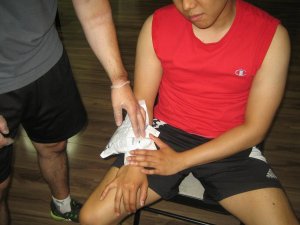
Poison ivy rashes usually occur after contact with the poison ivy plant, whether directly or indirectly. This is caused by sensitivity to urushiol. The oil resin is found in the plant’s leaves, stems and roots, and can remain active for years. Aside from poison ivy, urushiol is also found in poison oak and poison sumac. Mild cases of poison ivy rashes can be easily managed at home and does not need medical attention. However, for more extensive or severe rashes, especially if located on the face or genitalia, seek medical attention as extra care may be required.
Not everyone that comes into contact with poison ivy develops an allergic contact dermatitis, with only half developing the itchy rashes. The remaining half have immunity against urushiol, however, this immunity can either wear off or fortify through time. The rash itself is not usually contagious, even by contact with fluid from blisters. Rashes can only be passed on to another person by coming into contact with a person that still has urushiol on his/ her skin, clothes, etc.
Poison ivy (Toxicodendron radicans) is common in North America, including Canada. To avoid contact with poison ivy, one must be aware of its appearance. It is a climbing woody vine (sometimes appears as a shrub), typically found along riverbanks, with three pointed leaflets that change colors depending on the season. During spring, it appears reddish that turns green during summer and finally turns to different shades or red, orange and yellow in the fall.
What Causes Poison Ivy Rashes?
There are several ways of coming into contact with the urushiol causing the poison ivy rashes. Urushiol easily adheres to the skin, clothing, tools, equipment, and pet’s fur because it is very sticky. The following can lead to poison ivy rashes:
- Direct contact: direct touch with the berries, leaves, stem or roots
- Indirect contact: touching objects that are contaminated
- Inhalation: inhalation of smoke from the burning plants causing nasal or lung irritation
What are the Symptoms of Poison Ivy Rashes?
Reaction usually occurs within 12-48 hours after exposure and severity depends on the amount of urushiol that comes into contact with skin. The signs and symptoms of poison ivy rashes include:
- Intense itching, redness and swelling rashes that typically appears in a straight line.
- Blisters
How is First Aid Given to Treat and Manage Poison Ivy Rashes?
Poison ivy rashes typically last from one to three weeks. To give first aid for poison ivy rashes, the following steps are recommended:
- Meticulously wash the skin with warm water and soap. Perform this as soon as possible as this may prevent the oil from entering the skin.
- Use a brush to clean under the fingernails to remove plant oil and avoid spreading to other parts of the body.
- Immediately remove clothes and shoes as it may contain urushiol. Wash clothes and shoes with warm water and soap.
- Apply cool compress to the skin and wear light clothing. Avoid sweating as it can worsen itching.
- To minimize itching and blistering, apply calamine lotion and hydrocortisone cream. Also, bathing in lukewarm water with an oatmeal bath product may also reduce itching. If these products do not work, antihistamines may be given.
- Bathe animals that may have come into contact with the oil to remove it.
Disclaimer: This article should not be substituted for medical diagnosis or medical advice. The hints are for information purposes. To learn how to treat poison ivy rashes, enrol in first aid courses.

